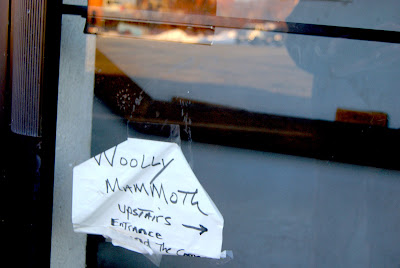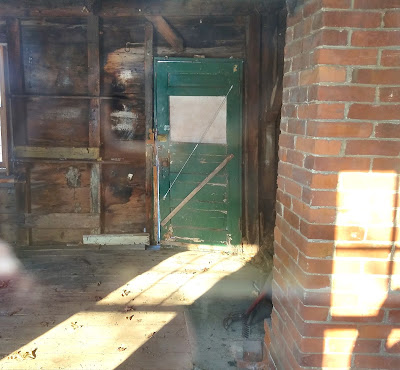From Rock N. Roller:

I've shot this building before, but only recently did I see it from the right angle to pick out the "C.F. Hathaway" ghost sign. I mean, look at that sunlight just knocking me upside the head and telling me to take a picture.
The first time I took pictures of this building on Elm Street in Waltham, Mass., was in early January 2013, I was strolling around this 'hood , which is just a stone's throw from the old Elm Street Music Hall, which I featured in the first post of a three-part series about Waltham (see November 9, 2016, "Brigham in Waltham, Part I"). On that jaunt five years ago, I noticed this ragged, hand-made sign:

I don't know if the powers-that-be at Woolly Mammoth Sound have put up a better sign since I snapped this picture. They probably don't need to. The recording studio is run by Dave Minehan, a Greater Boston rock legend.
Minehan founded the Neighborhoods, a mainstay of the Boston rock scene from the late '70s through the early '90s. The band toured with the Ramones and Cheap Trick, among others, before breaking up in 1992. The band re-formed a decade later and still plays today. In 2013, Minehan joined the Replacements for several gigs that the Band Formerly Known As the Most Drunk Band Ever played over the next two years. Minehan had big shoes to fill in the minds of Replacements fans: Slim Dunlap's (1987-1991), who played lead guitar on the band's last two studio albums, Don't Tell a Soul and All Shook Down, and who suffered a stroke in 2012; and Bob Stinson's (1979-1985), the band's founder and most colorful, yet ultimately tragic, member. Replacements singer Paul Westerberg booted Stinson from the band in 1986 due to his alcohol and drug problems. Stinson died in 1995 at age 35.

(Did some petulant rock star throw this TV out of a Woolly Mammoth studio window five years ago?)
Here's a Neighborhoods video:
And here's the Replacements featuring Dave Minehan:
Let's get back to the building itself, and C.F. Hathaway.
In addition to Woolly Mammoth, the building at 180 Elm Street is home to a bindery service, a furniture repair company, a woodworking business and an upholstery shop. Built in 1900, according to real estate web site LoopNet, the building is a converted mill.
As I do with just about everything I photograph and write about on this blog, I headed to Google for more information on "C.F. Hathaway." The first results got me very excited. "C. F. Hathaway Company was a private manufacturer of shirts for men and boys, located in Waterville, Maine," said the Wikipedia entry I found. "It was founded in 1837 and made uniform shirts for Union soldiers during the American Civil War."
"Wow!" I thought. "What a cool connection to this nation's history!" I dug deeper and found a 2002 New York Times article about how the company closed its factory in Maine, "the last major U.S. shirt plant." I read the article and realized that at no point did C.F. Hathaway make shirts in Waltham.
Damn.
But all was not lost. Just a little further into my online research, I found links at the Cambridge Public Library web site to Cambridge Chronicle articles that discussed C.F. Hathaway & Son, a North Cambridge bakery with a factory in, you guessed it, Waltham. Established in 1875, C.F. Hathaway & Son by 1910 had moved into the company's third location on Richdale Avenue in Cambridge, having outgrown the two prior bakeries in the city. The company is no longer in business; its North Cambridge location is now home to Hathaway Lofts.
According to this 1899 Chronicle article, Charles F. Hathaway set up shop in Cambridge as University City Bakery after working in bakeries in the area, as well as in Maine (hmm...Maine. Maybe there's a connection here?). In 1897 he bought a Waltham bakery (unnamed in the article), which employed 20. It's possible that the Elm Street building is older than 1900, but it's conceivable that the Waltham operation was run elsewhere and moved into that building later.
I'm not sure when the name of the company was changed to C.F. Hathaway.
Accompanying this Chronicle article from 1911 is a graphic that, if you enlarge it, shows the Waltham bakery. The article indicates that the Waltham bakery had the capacity to turn out 20,000 loaves of bread a day, and that its specialty "as in Cambridge is ice cream bread." I've never heard of ice cream bread, but I bet it's damn good, and that the rockers who hang out at Woolly Mammoth would enjoy it as well.
OK, might as well finish up on a rock 'n' roll note:










